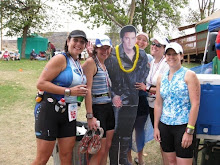How to Cope With the 5 Stages of Injury Grief
Runner’s World
For many of us, running is like a best friend. We count on it to quiet our anxieties, focus our minds, and make us happier, healthier, and saner. So what happens when injury strikes and takes away our trusted ally? We curse, we pout, we may even cry and scream. Sound excessive or irrational?
It’s not—in fact, experts say experiencing these emotions is normal and healthy. “The sense of loss an athlete feels when injured can be very similar to the other types of mourning or grief that occur in our lives,” says Diane Wiese-Bjornstal, Ph.D., associate professor of kinesiology at the University of Minnesota and a leading researcher of injury psychology. “It’s a huge sense of loss that you feel.”
In order to deal with this pain and frustration—and move on to recovery—Wiese-Bjornstal recommends sidelined runners adopt a specific grieving strategy. It may sound familiar—it’s what you’d go through if you lost a job or a pet. And if you’ve been injured before, you’ve probably stumbled through it unknowingly. The key is taking a purposeful approach. If you can recognize each stage of mourning, and work actively to move through each one, you’ll heal faster. And that means you’ll be back on your feet sooner.
The Stage: DENIAL
Ignorance Is Bliss
After running a 2:35 marathon in 2006, Michelle (nee Lilienthal) Frey was recruited by Team USA Minnesota and offered a sponsorship contract. She spent the next two years preparing for the 2008 Marathon Trials, where she hoped to make the Olympic team. A year before the race, the bottom of her leftfoot began to hurt. “But I kept running on it,” she says. Runners often play this game of Russian roulette—limping through workouts, disregarding red flags. “Runners in denial know they’re injured but won’t admit it,” Wiese-Bjornstal says.
MOVE ON
Getting stuck here is dangerous. “By denying you’re injured, you can exacerbate the injury,” says Jim Taylor, Ph.D., a sports psychologyconsultant and sub-three-hour marathoner in San Francisco. “What was once a minor tweak could turn into a major injury.” Which is what happened to Frey—she was crippled by plantar fasciitis for one year. Listen to your body. At the first sign of a potential injury, be smart and back off . A few days on the couch is better than months of physical therapy.
The Stage: ANGER
It’s Not Fair!
Not being able to run a goal race as fast as you had hoped—or at all—can be disappointing, even devastating. “I was like, Why is this happening to me before the biggest race of my life?” Frey says. It’s this sense of injustice that triggers anger. “You feel betrayed by your body, your training, the universe,” Taylor says.
MOVE ON
A positive outlook—as hard as that may be to summon—may be your greatest weapon. Research reports that athletes who use positive self-talk and set goals for their rehab experience “exceptional recovery.” So be angry for a few days, then look forward. Set rehab goals so you can celebrate small successes. If your therapy program includes planks, aim to hold the position for 15, then 30, then 60 seconds. When you reach each goal, recognize the achievement.
The Stage: BARGAINING
Just Let Me Exercise
When injured athletes finally confront their injury, they sometimes become too gung-ho. “You think, I’ll do more rehab, more often, more reps, more weights, and then I’ll get back to running sooner,” Wiese-Bjornstal says. “But more isn’t always better.” In Frey’s case, she began to scramble to fix the problem, seeing an extensive circuit of doctors to get second, third, and fourth opinions. “That, in itself, was draining,” she says. “I panicked.”
MOVE ON
Taking action to fix your problem is good, but don’t go overboard. “You can’t microwave healing,” Taylor says. “You have to slow bake it.” Obey your rehab prescription the same way you would a training program. (You wouldn’t do three long runs in one week, would you?) “If rehab goes well, you can come back a better athlete,” Taylor says. “Don’t jeopardize that ultimate goal.”
The Stage: DEPRESSION
What’s The Point?
Wiese-Bjornstal’s research shows that athletes with severe injuries that require long amounts of downtime are likely to linger in this stage. The enthusiasm you initially had for your rehab routine fades. You miss the endorphin fix running provided, and you feel cut off from the running and racing community.
MOVE ON
Fill your newfound downtime with other activities that help fill the void of running. Schedule time consuming sports you enjoy but can’t fit in when you’re training—as long as they don’t exacerbate your injury—golf, say, or leisurely bike tours. Stay connected to the running community: Cycle alongside friends on their long runs; invite your running buddies to a yogaclass you’ve started taking; volunteer at a race.
The Stage: ACCEPTANCE
It’s Working!
“This is when you are properly sticking with your rehab plan and you’re seeing progress,” Taylor says. You’ve accepted the injury, and also that you’ll eventually be back on your feet. Coming to this mindset is critical to recovery. Research shows a direct relationship between stress and injury. Anxiety can cause muscle tension and suppress immune function, which can delay how quickly you get better. In this stage, you have a peaceful mindset that encourages healing.
After faltering her way through these stages, Frey says she’s confident that if confronted with an injury again, she’d reach acceptance—and recovery—sooner. It was a hard lesson to learn: She was the 10th fastest woman going into the 2008 Trials, but ultimately placed 85th. Her sights are now set on the 2012 Olympic Marathon Trials. By listening to her body, and not lingering in denial, she’s hoping to avoid the grief of injury.





















No comments:
Post a Comment